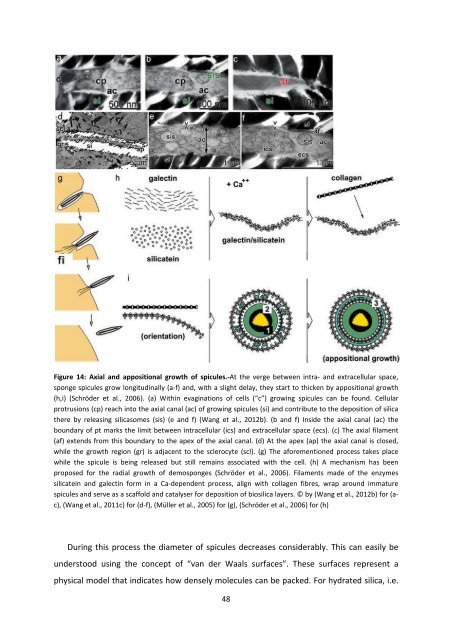MASTER THESIS Biomimetic potential of sponge ... - IAP/TU Wien
MASTER THESIS Biomimetic potential of sponge ... - IAP/TU Wien
MASTER THESIS Biomimetic potential of sponge ... - IAP/TU Wien
Create successful ePaper yourself
Turn your PDF publications into a flip-book with our unique Google optimized e-Paper software.
Figure 14: Axial and appositional growth <strong>of</strong> spicules.-At the verge between intra- and extracellular space,<br />
<strong>sponge</strong> spicules grow longitudinally (a-f) and, with a slight delay, they start to thicken by appositional growth<br />
(h,i) (Schröder et al., 2006). (a) Within evaginations <strong>of</strong> cells (“c”) growing spicules can be found. Cellular<br />
protrusions (cp) reach into the axial canal (ac) <strong>of</strong> growing spicules (si) and contribute to the deposition <strong>of</strong> silica<br />
there by releasing silicasomes (sis) (e and f) (Wang et al., 2012b). (b and f) Inside the axial canal (ac) the<br />
boundary <strong>of</strong> pt marks the limit between intracellular (ics) and extracellular space (ecs). (c) The axial filament<br />
(af) extends from this boundary to the apex <strong>of</strong> the axial canal. (d) At the apex (ap) the axial canal is closed,<br />
while the growth region (gr) is adjacent to the sclerocyte (scl). (g) The aforementioned process takes place<br />
while the spicule is being released but still remains associated with the cell. (h) A mechanism has been<br />
proposed for the radial growth <strong>of</strong> demo<strong>sponge</strong>s (Schröder et al., 2006). Filaments made <strong>of</strong> the enzymes<br />
silicatein and galectin form in a Ca-dependent process, align with collagen fibres, wrap around immature<br />
spicules and serve as a scaffold and catalyser for deposition <strong>of</strong> biosilica layers. © by (Wang et al., 2012b) for (ac),<br />
(Wang et al., 2011c) for (d-f), (Müller et al., 2005) for (g), (Schröder et al., 2006) for (h)<br />
During this process the diameter <strong>of</strong> spicules decreases considerably. This can easily be<br />
understood using the concept <strong>of</strong> “van der Waals surfaces”. These surfaces represent a<br />
physical model that indicates how densely molecules can be packed. For hydrated silica, i.e.<br />
48

















